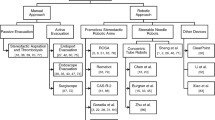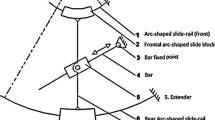Abstract
Background
Intracerebral hemorrhage (ICH) is one of the deadliest forms of stroke in the USA. Conventional surgical techniques such as craniotomy or stereotactic aspiration disrupt a large volume of healthy brain tissue in their attempts to reach the surgical site. Consequently, the surviving patients suffer from debilitating complications.
Methods
We fabricated a novel MR-conditional steerable needle robot for ICH treatment. The robot system is powered by a custom-designed high power and low-cost pneumatic motor. We tested the robot’s targeting accuracy and MR-conditionality performance, and performed phantom evacuation experiment under MR image guidance.
Results
Experiments demonstrate that the robotic hardware is MR-conditional; the robot has the targeting accuracy of 1.26 ± 1.22 mm in bench-top tests. With real-time MRI guidance, the robot successfully reached the desired target and evacuated an 11.3 ml phantom hematoma in 9 min.
Conclusion
MRI-guided steerable needle robotic system is a potentially feasible approach for ICH treatment by providing accurate needle guidance and intraoperative surgical outcome evaluation.












Similar content being viewed by others
References
Tapia-Perez JH, Zilke R, Schneider T (2016) Match-study of statin therapy in spontaneous intracerebral hemorrhage: is the discontinuation reasonable? J Neurosurg Sci 60:301–312
Etminan N, Beseoglu K, Turowski B, Steiger H-J, Hänggi D (2012) Perfusion CT in patients with spontaneous lobar intracerebral hemorrhage: effect of surgery on perihemorrhagic perfusion. Stroke 43:759–763
Elijovich L, Patel PV, Hemphill JC (2008) Intracerebral hemorrhage. Semin Neurol 28(5):657–667
Maira G, Anile C, Colosimo C, Rossi GF (2002) Surgical treatment of primary supratentorial intracerebral hemorrhage in stuporous and comatose patients. Neurol Res 24:54–60
Burgner J, Swaney PJ, Lathrop RA, Weaver KD, Webster RJ (2013) Debulking from within: a robotic steerable cannula for intracerebral hemorrhage evacuation. IEEE Trans Biomed Eng 60:2567–2575
Granna J, Godage IS, Wirz R, Weaver KD, Webster RJ, Burgner-Kahrs J (2016) A 3-D volume coverage path planning algorithm with application to intracerebral hemorrhage evacuation. IEEE Robot Autom Lett 1:876–883
Godage IS, Remirez AA, Wirz R, Weaver KD, Burgner-Kahrs J, Webster RJ (2015) Robotic intracerebral hemorrhage evacuation: an in-scanner approach with concentric tube robots. In: 2015 IEEE/RSJ international conference on intelligent robots and systems (IROS), 2015, pp 1447–1452
Miga MI, Paulsen KD, Hoopes PJ, Kennedy FE, Hartov A, Roberts DW (2000) In vivo quantification of a homogeneous brain deformation model for updating preoperative images during surgery. IEEE Trans Biomed Eng 47:266–273
Fiebach JB, Schellinger PD, Gass A, Kucinski T, Siebler M, Villringer A, Ölkers P, Hirsch JG, Heiland S, Wilde P (2004) Stroke magnetic resonance imaging is accurate in hyperacute intracerebral hemorrhage: a multicenter study on the validity of stroke imaging. Stroke 35:502–506
Jolesz FA (2003) Future perspectives in intraoperative imaging. In: Bernays RL, Imhof HG, Yonekawa Y (eds) Intraoperative Imaging in Neurosurgery, vol 85. Springer, Vienna, pp 7–13
Sengupta S, Tadanki S, Gore JC, Welch EB (2014) Prospective real-time head motion correction using inductively coupled wireless NMR probes. Magn Reson Med 72:971–985
Wang W, Viswanathan AN, Damato AL, Chen Y, Tse Z, Pan L, Tokuda J, Seethamraju RT, Dumoulin CL, Schmidt EJ (2015) Evaluation of an active magnetic resonance tracking system for interstitial brachytherapy. Med Phys 42:7114–7121
Chen Y, Wang W, Schmidt EJ, Kwok K-W, Viswanathan AN, Cormack R, Tse ZTH (2016) Design and fabrication of MR-tracked metallic stylet for gynecologic brachytherapy. IEEE/ASME Trans Mechatron 21:956–962
Kwok K-W, Lee K-H, Chen Y, Wang W, Hu Y, Chow GC, Zhang HS, Stevenson WG, Kwong RY, Luk W (2014) Interfacing fast multi-phase cardiac image registration with MRI-based catheter tracking for MRI-guided electrophysiological ablative procedures. Am Heart Assoc, Dallas
Kwok K-W, Chen Y, Chau TC, Luk W, Nilsson KR, Schmidt EJ, Zion TT (2014) MRI-based visual and haptic catheter feedback: simulating a novel system’s contribution to efficient and safe MRI-guided cardiac electrophysiology procedures. J Cardiovasc Magn Reson 16:O50
Chen Y, Zion TT, Wang W, Kwong RY, Stevenson WG, Schmidt EJ (2015) Intra-cardiac MR imaging and MR-tracking catheter for improved MR-guided EP. J Cardiovasc Magn Reson 17:P237
Masamune K, Kobayashi E, Masutani Y, Suzuki M, Dohi T, Iseki H, Takakura K (1995) Development of an MRI-compatible needle insertion manipulator for stereotactic neurosurgery. J Image Guided Surg 1:242–248
Pandya S, Motkoski JW, Serrano-Almeida C, Greer AD, Latour I, Sutherland GR (2009) Advancing neurosurgery with image-guided robotics. J Neurosurg 111:1141–1149
Sheng J, Desai JP (2015) Towards a SMA-actuated neurosurgical intracerebral hemorrhage evacuation (NICHE) robot. In: 2015 IEEE/RSJ international conference on intelligent robots and systems (IROS), pp 3805–3810
Su H, Li G, Rucker DC, Webster RJ III, Fischer GS (2016) A concentric tube continuum robot with piezoelectric actuation for MRI-guided closed-loop targeting. Ann Biomed Eng 44:2863–2873
Chen Y, Godage IS, Sengupta S, Liu CL, Weaver KD, Barth EJ, Webster RJ (2017) An MRI-compatible robot for intracerebral hemorrhage removal. In: 2017 design of medical devices conference, pp V001T08A019–V001T08A019
ASTM. F2503 (2005) Standard practice for marking medical devices and other items for safety in the magnetic resonance environment. http://www.astm.org/. Accessed 21 Jan 2018
Bushby K, Cole T, Matthews J, Goodship J (1992) Centiles for adult head circumference. Arch Dis Child 67:1286–1287
Chen Y, Godage IS, Tse ZTH, Webster RJ, Barth EJ (2017) Characterization and control of a pneumatic motor for MR-conditional robotic applications. IEEE/ASME Trans Mechatron 22:2780–2789
Whitney DE (1969) Resolved motion rate control of manipulators and human prostheses. IEEE Trans Man Mach Syst 10:47–53
Chan AY, Tran DKT, Gill AS, Hsu FP, Vadera S (2016) Stereotactic robot-assisted MRI-guided laser thermal ablation of radiation necrosis in the posterior cranial fossa. Neurosurg Focus 41:E5
Fitzpatrick JM, West JB, Maurer CR Jr (1998) Predicting error in rigid-body point-based registration. IEEE Trans Med Imaging 17:694–702
Sinclair T, Mougenot C, Kivinen J (2012) MatMRI and MatHIFU: Matlab toolboxes for real-time monitoring and control of MR-HIFU. In: 12th international society for therapeutic ultrasound symposium, Heidelberg, Germany, pp 156–161
Chen Y, Kwok K-W, Tse ZTH (2014) An MR-conditional high-torque pneumatic stepper motor for MRI-guided and robot-assisted intervention. Ann Biomed Eng 42:1823–1833
Chen Y, Mershon CD, Tse ZTH (2015) A 10-mm MR-conditional unidirectional pneumatic stepper motor. IEEE/ASME Trans Mechatron 20:782–788
Chen Y, Squires A, Seifabadi R, Xu S, Agarwal HK, Bernardo M, Pinto PA, Choyke P, Wood B, Tse ZTH (2017) Robotic system for MRI-guided focal laser ablation in the prostate. IEEE/ASME Trans Mechatron 22:107–114
Acknowledgements
This work was funded by the National Institutes of Health: Grant R21NS091735-01.
Author information
Authors and Affiliations
Corresponding author
Ethics declarations
Conflict of interest
The authors declare that they have no conflict of interest.
Ethical approval
This article does not contain any studies with human participants or animals performed by any of the authors.
Informed consent
This article does not contain patient data.
Rights and permissions
About this article
Cite this article
Chen, Y., Godage, I.S., Sengupta, S. et al. MR-conditional steerable needle robot for intracerebral hemorrhage removal. Int J CARS 14, 105–115 (2019). https://doi.org/10.1007/s11548-018-1854-z
Received:
Accepted:
Published:
Issue Date:
DOI: https://doi.org/10.1007/s11548-018-1854-z




